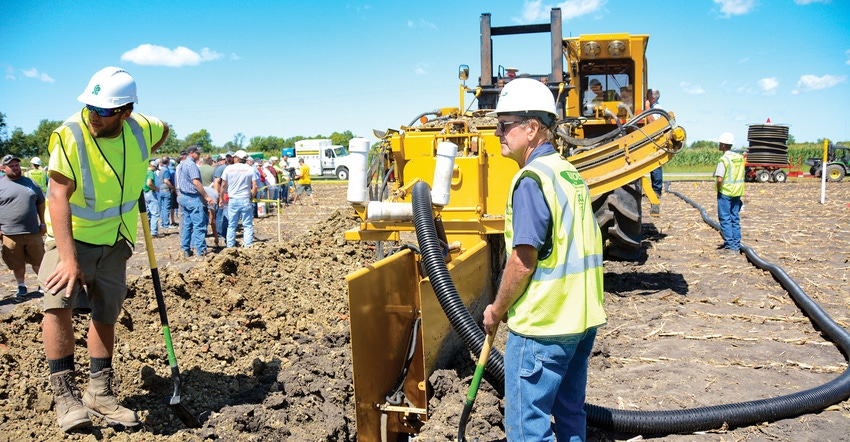
Installing tile is one of the practices farmers in the eastern Corn Belt mention most often in finding ways to improve yields and overall profitability. If you’re thinking about investing in tile, you won’t want to miss the tiling demonstrations scheduled daily at the 2021 Farm Progress Show, weather permitting, Aug. 31 to Sept. 2 in Decatur, Ill.
David Brix, a host farmer and supervisor of tiling demonstrations, says that more than 30 acres are scheduled to be tiled during the show. Most of the land is farmed by Brix and his wife, with a small amount owned by an adjacent landowner.
The demonstrations will commence each day at noon and continue for about an hour, or until the tillage demos fire up each day. Members of the Illinois Land Improvement Contractors Association will provide the equipment and operators to install the tile. Brix expects several self-propelled tile plows will be on hand to complete the work and demonstrate how various machines operate.
Continuing project
Tiling demonstrations first began in 2013 at the Decatur, Ill., site when mains were installed to pattern-tile a large field. Since then, laterals have been installed each time the show is in Decatur. Brix says mostly 4-inch laterals on 50-foot centers will be installed this year, along with some 6- and 8-inch sub-tiles moving east across the field.
This year’s tiling demonstrations will be directly north of the exhibit field. Tile added this year will connect with tile installed in previous years to increase the amount of acreage pattern-tiled within the field. Most of the prairie soils where the show site is located are naturally poorly or somewhat poorly drained, and generally benefit from tiling. Brix estimates that 22,000 feet of tile will be installed this year.
Bioreactor installation
A bioreactor will also be installed during the show and will be part of the tiling demonstration, weather permitting.
“This will be the third one we have installed on our property, and the one we’re installing this year is fairly close to one installed previously,” Brix says.
Visitors will be able to view the completed bioreactor, as well as see the new one under construction.
The goal of the bioreactors is to remove nitrate from a portion of the tile water before it leaves the field. The USDA Natural Resources Conservation Service promotes installation of bioreactors to help reduce nitrate levels in streamflow. Nitrate is one of the nutrients that contributes to hypoxia in the Gulf of Mexico, according to environmental experts.
The bioreactors installed on Brix’s farm are about 30 feet long by 20 feet wide, and 4 to 5 inches deep. After installing piping to direct water flow and a plastic liner, the bioreactor is filled with wood chips. It’s the wood chips that help remove nitrates from water passing through the reactor before it rejoins the tile line.
Not all the water typically goes through the bioreactor in a farm field setting. Once the bioreactor is installed, a berm is placed around it, and it’s necessary to farm around that. After wood chips settle and decay over time, more wood chips can be added to existing bioreactors.
About the Author(s)
You May Also Like




